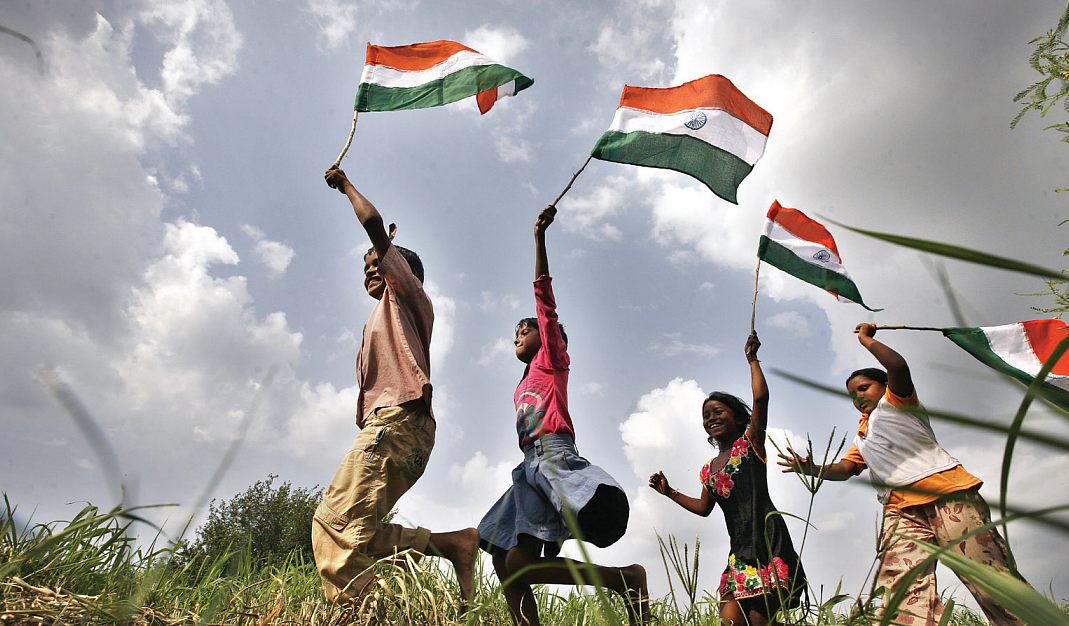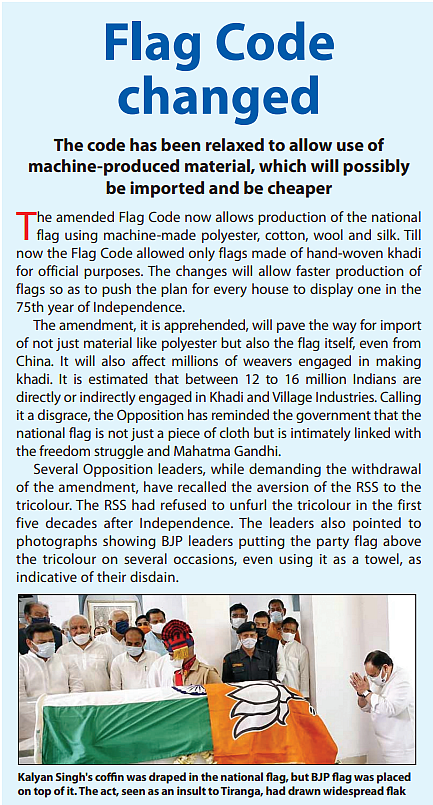For women behind the tri-Colour: Past imperfect, Future tense
The Government’s decision to change the Flag Code and allow machine-made national flags will effectively hasten the demise of Khadi and village industry, writes Ganesh Devy

Women who have been making the national flag in Hubballi (Karnataka) since 2003 hoped the 75th year of Independence would bring more work, better earnings and hope for the future of their children. But a recent government decision has put paid to that hope.
The Indian Bureau of Standards, which strictly regulated the handwoven and hand-stitched national flag’s precise dimensions, weave, folding and stitching of its borders, has opened a floodgate for non-khadi flags at government offices. The revised standard will permit flags made of polyester. There will be no insistence that they be made at the officially licensed flag-making centre. Recent media reports say that there is a move to import flags from China as well.
It was not long ago that the central government had banned some of the Chinese apps following Chinese aggression in Ladakh. To move from that stand to allowing import of Indian flags to substitute flags made in India appears absurd.
The Union government would normally place orders to produce flags worth Rs. 3-4 crore every year to the national flag manufacturing unit in North Karnataka. The Covid pandemic brought down the sales to just 30 percent. The result was that the women had less work and their earnings sunk. No pandemicspecial relief ever reached them. With the new decision to change the flag code, the work orders would shrink further.
The khadi spun on thousands of hand-run charkhas at Tulasigeri village in Bagalkot is used by the Khadi Gromodyog Samyukta Sangh (KGSS) in Hubballi (earlier Hubli), which was founded in November 1957 and the national flag manufacturing unit was set up in 2004. In 2006 it received an award for excellence and was certified by Bureau of Indian Standards (BIS).

Since then, all officially used flags are manufactured in accordance to rigorous BIS standards.
The government’s decision to import flags for mass-distribution has sounded the death knell of the Khadi Flag making within the country. It is really difficult to decide if the government wants the people of India to forget khadi or forget that the flag is born out of the freedom struggle. Such a strange decision can be made only by those whose parent organisation has continuously refused to fly the Indian tri-colour at its campus.
The flag-making centre is also a microcosm for the spirit of free India in many ways. Its founder Venkatesh Madagi was born on 26th January 1903, forty-seven years before India became a republic. The oldest among the workers at the centre, Nooranna was born in 1947. He is one of the few men who have been working with the KHSS.
The work force is almost entirely made of women, the real makers of the flags of India. All of us who are proud of India for its composite social weave will be happy to know that the women come from all communities-- Muslims, Jains, Christians, Dalits, Adivasis, Lingayats, Buddhists and Hindus.
A Muslim Noorjahan working with a Scheduled Caste Nayana and a Christian Janet working with a Lingayat Akkamma marks the ethnography of the makers of India’s flag. The idea of India as envisioned by the makers of India can nowhere else be seen in such graphic reality as at this Centre.

As the women spoke about their life, many could not hold back tears in their eyes. They told me that even after working for eight to 10 hours a day, their daily earning is close to a meagre Rs. 150. The monthly earnings have remained the same, in most cases a little under four thousand rupees a month. They get neither annual increments nor any pension. Paid maternity leave and LTA are words foreign to them.
I asked them why they do not find another occupation. Their response left me humbled. “We love India. It is our service to the nation. And Gandhi had used khadi as a holy weapon against oppression. We are keeping it alive. Besides, sir, tell us where are the jobs for us?”
It is difficult to say when in history a piece of cloth came to be seen as the most important insignia of the pride and honour of people. The ancient Indian word ‘dhwaj’ and the Old Norse ‘flaka’ (meaning to flicker or to flutter) have been in circulation for long. The Danish ‘Dennebrog’ is fabled to have fallen from the skies and has been in use for the last eight centuries.
Yet, the national flag as a semiotic signature of a people is decidedly related to the idea of ‘a community of nations’, within which each nation is represented by a proudly fluttering piece of cloth, its national flag. Over the last two centuries, as nation after another modern nation took birth, it was immediately draped in a national flag.
Our national flag is no ordinary flag. It symbolises the great historic struggle for independence. On this background, the shrill public proclamation of nationalism sounds so hollow when one notices how completely neglected are the labourers that make India a nation.
The brand of nationalism that is currently on the block needs to know that nation is made of its people, its composite society, its vast population capable of love and sacrifice and not just a few super-rich individuals or a bunch of people promoting arcane ideas spreading false pride in imagined glories of a distant past.
The tricolour is our most sacred symbol. Every time I salute it, pride for India wells up in my heart. Yet, is that pride enough to conceal the pathos, suffering, agony, hunger and pain of those who toil in order to keep symbolism for the rest of India alive?
(The writer is a cultural activist)
(This was first published in National Herald on Sunday)
Follow us on: Facebook, Twitter, Google News, Instagram
Join our official telegram channel (@nationalherald) and stay updated with the latest headlines
Published: 16 Jul 2022, 12:00 PM